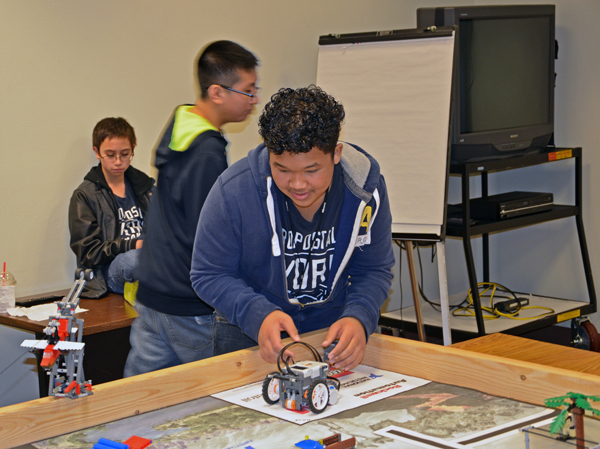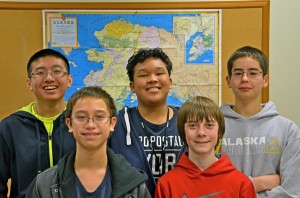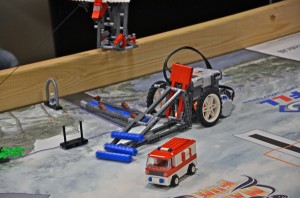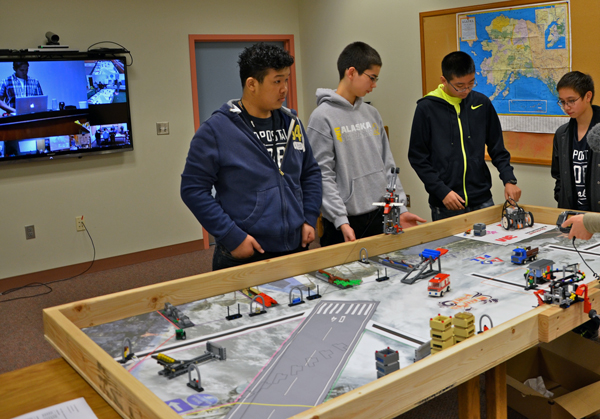
This month, five rural Alaska schools squared off in a virtual engineering competition run by Lego and GCI.
It was a big learning experience for everyone – but especially, for the squad from Unalaska.

They were competing for the first time, and they brought some unique strengths to the table.
At 8:30 on a Saturday morning, most teenage boys are still asleep. Even if they’re not, they probably aren’t playing with Legos.
But here in Unalaska, five junior high boys are gathered in the public library. They’ve got a motorized truck they built out of Legos, and a giant game board.
“Well, the theme is Nature’s Fury,” Brian Conwell, the captain of the Unalaska Raiders robotics team, said. “So all this, relates to natural disasters and stuff.”
They’re part of a national Lego league that’s meant to get kids interested in engineering.
Unalaska and other schools are going to compete today to see who designed the best robot. They’ve all got the same course to test them out on. It looks like a town hit by a big disaster.

The Unalaska Raiders practice driving their robot on it. They try to pick up two Lego pets and take them to the safe house where their owner is waiting.
“OH! Awwww. The person’s not in though,” they say, with the whirring of the robot’s engine in the background.
The truck shoves the pets into the house, but pushes so hard the human owner pops out – not good.
Johnny Khongsuk and Kennan Jordan go over to their computer to see if they can work out the kinks in the program.
Getting the robot to do the basics was harder than they thought, Kennan says.
KJ: “With ours, uh, forward is backward and backward is forward.”
LR: “How did that happen?”
KJ: “Uh, I think we reversed the motors by accident.”
Solving problems is a big part of Lego league – especially for teams in rural Alaska.
Big Lake, Holy Cross, McGrath, Valdez and Unalaska are all too far-flung to travel to a Lego meet. So GCI is hosting a videoconference for them today. And GCI employees are serving as judges.

They interview each team, to start, and they ask some pretty tough questions about establishing goals.
Judge: “I’m curious if you can tell me, did you have fun doing this?”
UR: “So much, a lot of it.”
Judge: “Did you look forward to doing it?”
UR: “Yeah.”
Judge “You would definitely do it again?”
UR: “Yeah…”
Judge: “It looks like you guys did have fun doing it.”
That actually counts for a lot. Part of the challenge here is to manage a project, and still be creative.
The Unalaska Raiders think they’ve got that part covered. They have to present a research project on natural disasters – their topic was tsunamis. But to get the message across, they picked a nontraditional medium.
Jonathan Le jumps into a rap about emergency alert systems.
JL: “Waves are crashing by the shore, I can’t handle this no more. There’s this thing on its way. Better run, or else you’ll pay. That thing is a tsunami and I can’t find my mommy. Gotta send this text real fast, so this town will forever last.”
After the presentations are wrapped up, it’s finally time for the competition – Unalaska and Valdez are up first. A volunteer referee appears on-screen in a headset and striped jersey.
Referee: “Alright! Then we are ready to go in five, four, three, two, one – LEGO!”
JK: “Uh! Do it again!”
The Raiders try over and over to knock down a stack of blue pins that are supposed to be a tsunami. But the pins don’t budge. Soon enough – time is up and the referee counts up their points.

“Unfortunately, you guys had a score of zero this match,” the referee said.
The team is disappointed.
But when the next match starts, they focus on tasks they know the robot can accomplish. And after each race, their score inches up. At the end of the day, Unalaska doesn’t have the most points. That honor goes to Valdez.
But it wasn’t just about high scores. The judges recognize teams that were strong in the fundamentals, like teamwork.
“Also in problem solving and fixing problems, and that goes to Unalaska,” the judge said.
The Raiders are pretty proud, but they know they’ve got more work ahead to do – new programs to write, and bugs to fix.
But it can wait. After driving robots for four hours, it’s time to put aside childish things, and take a nap.




